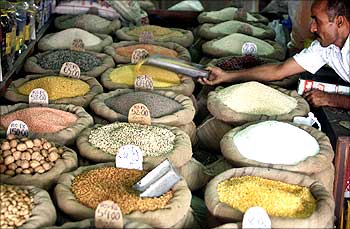 With the inflation rate of pulses still in double digits for more than a year, the government today said the supply of pulses would remain a critical problem for another two to three years.
With the inflation rate of pulses still in double digits for more than a year, the government today said the supply of pulses would remain a critical problem for another two to three years.
The government is expecting an increase of two million tonnes (mt) in production of pulses in the current crop year (July 2010-June 2011).
"So far as pulses are concerned, it is going to be a critical problem not only for now, but will be a problem for the next 2-3 years.
"This is because we don't have enough and our supply-demand mismatch is estimated at 6 mt," said Cabinet Secretary K M Chandrasekhar in the context of rising prices of food commodities at a conference organised by industry body Confederation of Indian industry here.
The Ministry of Agriculture, in its latest estimates, had lowered its projection of the production of pulses to 14.59 mt from the earlier estimate of 14.77 mt in the 2009-10 crop year.
However, even as the latest estimates are lower than previous projections, it is still marginally higher that the production in 2008-09 at 14.57 mt.
The average rate of wholesale inflation of pulses was at 34.6 per cent in the January-June period.
"There is a gap in pulses production (and demand). We are targeting 16.5 mt this year, which is a two-million tonne jump over the previous year. Because of good rains, we hope to have good pulses production this year," Agriculture Secretary P K Basu told reporters at the same event.
Even as production is on the rise on a year-on-year basis, it is insufficient to meet the domestic demand, which is pegged at 18-19 mt. In India, pulses are the main source of protein and hence witnesses high demand.
Chandrasekhar added that the government would augment the import of pulses and was taking steps to bridge the gap between demand and supply. India had imported 3.5 mt pulses in the previous financial year (2009-10).






